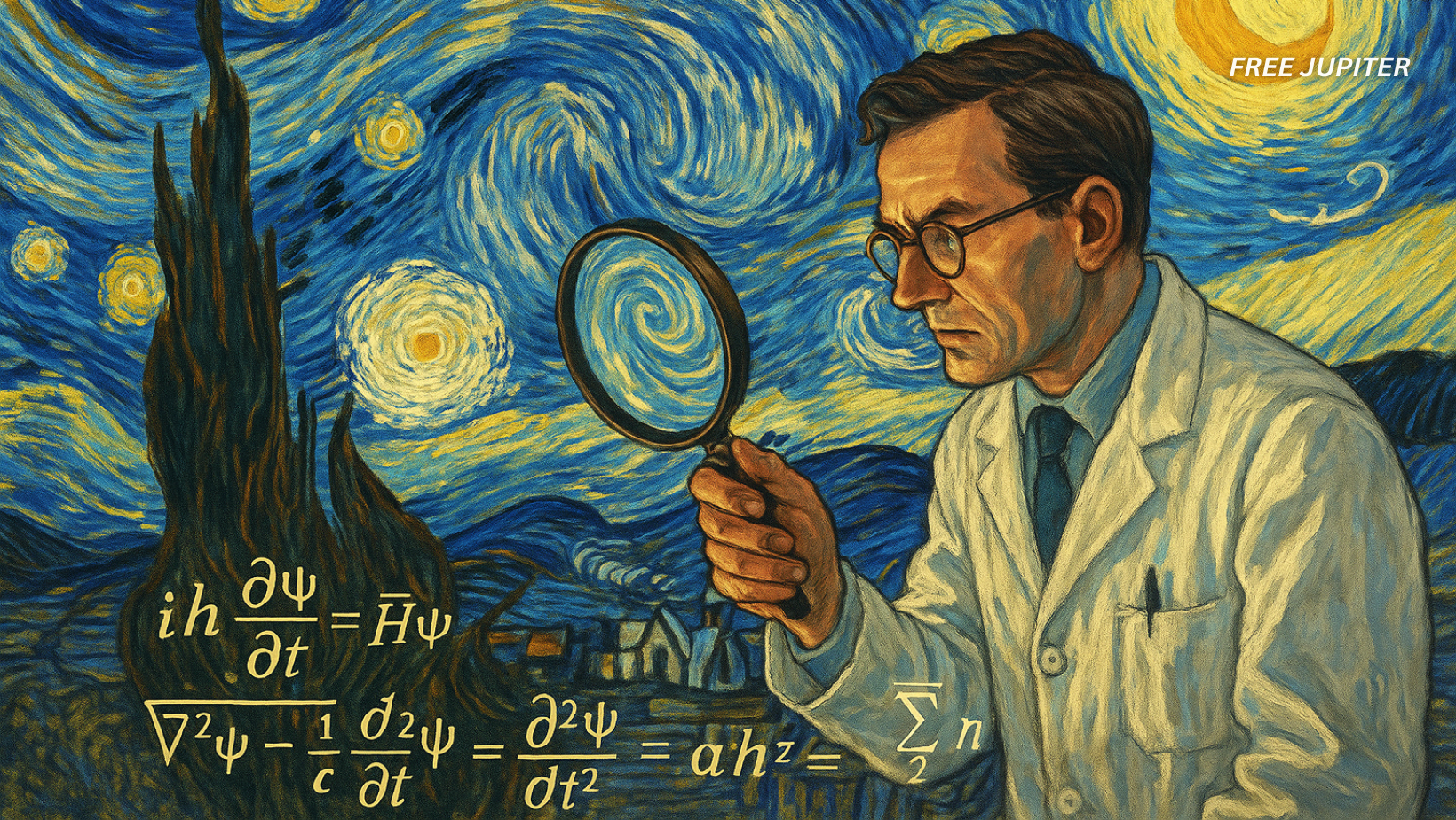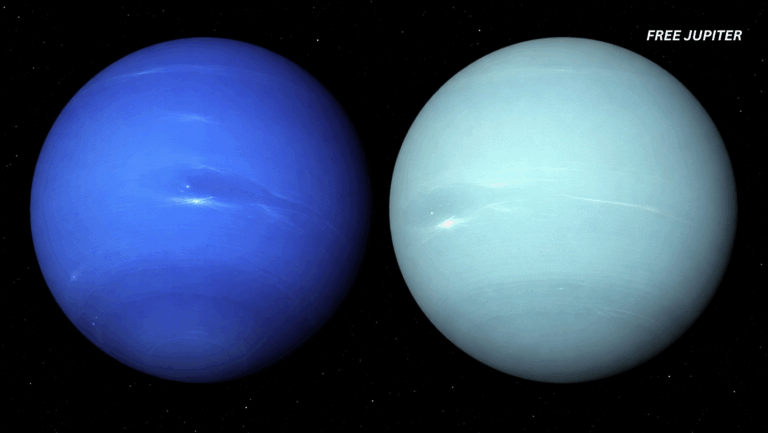Friendly Note: FreeJupiter.com shares general info for curious minds 🌟 Please fact-check all claims—and always check health matters with a professional 💙
Vincent van Gogh’s The Starry Night is one of the most beloved paintings in the world, famous for its swirling, glowing sky that seems alive with motion.
But recent scientific research has revealed that this iconic artwork also contains a surprising secret: it closely follows real physical laws that govern how air and clouds move in nature.
This discovery shows that van Gogh had an intuitive grasp of the natural world’s hidden dynamics, captured through his bold brushstrokes and vivid colors.
The Painting’s Background and Visual Impact
Created in June 1889 while van Gogh was staying in a mental asylum in Saint-Rémy-de-Provence, France, The Starry Night depicts a night sky filled with swirling blue waves, bright yellow stars, and a glowing crescent moon.
The scene combines the view from van Gogh’s window with an imaginary village in the foreground. Each star is surrounded by rippling halos of light, resembling reflections on water. These patterns are not just artistic choices—they mirror the complex, swirling motions found in turbulent air currents.
Scientists Explore the Hidden Physics in the Swirls
A team of researchers from China and France, specializing in fluid dynamics—the study of how liquids and gases move—examined a high-resolution digital image of the painting.
They carefully measured the size, spacing, and brightness of the swirling brushstrokes, focusing on 14 main whirlpool-like shapes in the sky. Their goal was to see if these swirling patterns matched known physical laws describing turbulence—the chaotic yet patterned movement of fluids like air and water.
Van Gogh’s Swirls and Kolmogorov’s Turbulence Theory
The researchers found that the swirling shapes in The Starry Night align remarkably well with Kolmogorov’s theory of turbulence, a mathematical description developed decades after van Gogh’s death.
This theory explains how energy flows through turbulent systems, breaking down from large swirls (called eddies) into smaller and smaller ones in a predictable manner.
The painting’s brushstrokes also fit Batchelor’s scaling, which describes how tiny swirls behave before they fade away.
Interestingly, the brightness of the yellows in the painting seems to represent the flow of energy through these turbulent patterns. This suggests that van Gogh’s depiction of the sky is not just emotional or symbolic, but also scientifically accurate in its portrayal of atmospheric movement.
Read more: Humpback Whales Are Trying To Send Messages To Humans: How They Are Communicating With Us
Intuition or Observation? Van Gogh’s Hidden Genius
Of course, van Gogh couldn’t have known about Kolmogorov’s or Batchelor’s theories—they were formulated many years after his death. Instead, the scientists believe that van Gogh’s accurate depiction likely came from careful observation of the sky and clouds, or perhaps an innate ability to capture natural dynamism.
His brushwork reflects a deep, intuitive understanding of how nature moves, whether through watching real clouds or sensing the energy of the sky.
Why This Discovery Matters
This new insight adds a fascinating layer to The Starry Night. It’s not only a window into van Gogh’s emotional and artistic world but also a vivid representation of the natural forces shaping our environment.
The painting’s swirling sky resembles other natural phenomena, such as the storm patterns on Jupiter recently captured by NASA’s Juno probe, or even the swarming behavior of bacteria colonies studied by microbiologists.
The connection between art and science here is profound: van Gogh’s work shows that artistic intuition can sometimes anticipate scientific understanding.
His painting bridges the gap between creative expression and the laws of physics, revealing that both art and science seek to describe the beauty and complexity of the world around us.
Read more: Giving Up Your Phone For Just Three Days Can Significantly Improve Brain Function
Related Stories: Exploring the Science Behind The Starry Night
1. Hidden Turbulence in Van Gogh’s The Starry Night
A detailed scientific study analyzed all the swirling eddies in the painting, not just parts of it, and found that their sizes, distances, and intensities follow the physical laws of turbulence exactly as described by Kolmogorov’s cascade theory.
The researchers also detected a “–1” power-law pattern at smaller scales, indicating Batchelor-type scalar turbulence, which is rare and notable in atmospheric physics.
This study reveals that van Gogh’s brushwork captures the complex structure of turbulent air flows with extraordinary precision, suggesting he was a keen observer of natural phenomena.
2. The Starry Night Accurately Depicts a Scientific Theory That Wasn’t Described Until Years After Van Gogh’s Death
This article highlights how van Gogh’s swirling sky matches Kolmogorov’s turbulence theory, which explains how large swirling motions break down into smaller ones in fluids like air and water.
The research team measured 14 main swirling shapes in the painting and found they align with these scientific patterns. While van Gogh couldn’t have known the theory, his detailed observation or innate artistic sense allowed him to intuitively capture the dynamism of the sky.
Experts note that this is unlikely to be a coincidence, showing a deep connection between artistic expression and natural laws.
3. Van Gogh’s Starry Night Reveals Hidden Turbulence
This study used the brightness of van Gogh’s brushstrokes as a proxy for kinetic energy in the atmosphere and found that the painting follows two important turbulence laws: Kolmogorov’s law for large-scale energy transfer and Batchelor’s scaling for small-scale turbulence.
The dual presence of these laws in one depiction is rare and underscores the scientific significance of van Gogh’s intuitive artistry. The research suggests that the artist captured the physics of atmospheric movement with surprising accuracy.
4. Vincent Van Gogh’s ‘The Starry Night’: A Masterpiece of Art and Natural Turbulence Unveiled by Physics (ArteFuse)
This article explores how van Gogh’s emotional turmoil and artistic genius combined with natural observation to produce a painting that visually encodes the mathematics of turbulent flow.
The research team used digital imaging to analyze the 14 main eddies in the sky and found their arrangement and intensity match Kolmogorov’s turbulence theory. The study also notes Batchelor’s scaling in the small-scale paint mixing, linking the painting’s chaotic beauty to universal physical phenomena.
Related video: Voyager Probes Stumble Upon a Cosmic ‘Wall of Fire’ Outside Of Our Solar System
5. Van Gogh’s ‘Starry Night’ Actually Captured 2 Laws of Physics With Amazing Accuracy
Researchers from China and France discovered that van Gogh’s swirling patterns follow two main turbulence patterns: Kolmogorov’s −5/3 scaling law and Batchelor’s −1 scaling.
These findings suggest that van Gogh’s painting is more scientifically accurate than previously thought, especially in how it captures the flow of energy in turbulent air. The study highlights the unexpected harmony between art and science in van Gogh’s work.
This blend of art and science invites us to look at The Starry Night not only as a masterpiece of emotional expression but also as a remarkable, almost scientific, portrayal of nature’s hidden forces.
Van Gogh’s swirling skies remind us that sometimes, creativity and intuition can reveal truths about the universe long before science puts them into formulas.










